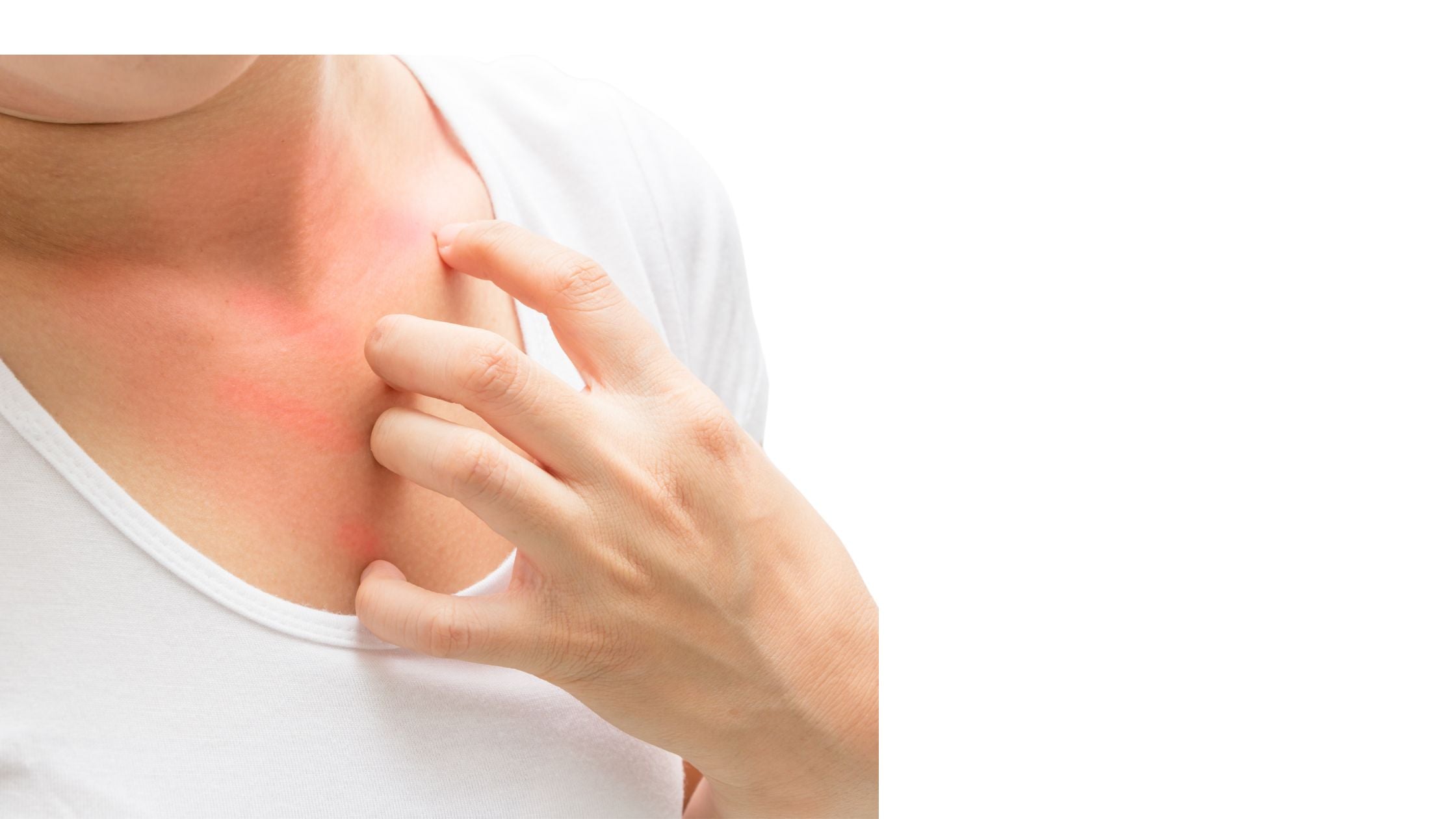
Dermatitis: Types, Causes, Treatments
There's not much worse than bringing home a brand new skin care product that you're excited to try out, but instead of the healthy, radiant glow you were hoping for, you get breakouts, redness, and itching. If you've experience skin problems from skin care products or anything else that touches your skin, you're not alone, and you're likely experiencing what's called dermatitis.
What is Dermatitis?
Put simply, dermatitis is skin irritation or inflammation caused by direct contact with an allergen or irritant. Since there are many irritants and allergens in the products we use daily, dermatitis is very common, and even if you don't have any diagnosable allergies you can still experience it.
Types of Dermatitis
There are several types of dermatitis, including:
- Contact Dermatitis: This happens when the skin touches or comes into direct contact with an irritant or allergen that causes a reaction. Common irritants include soaps, detergents, certain metals, and chemicals. Allergic contact dermatitis is a specific form that occurs when the body's immune system reacts to a substance it is allergic to. With allergic contact dermatitis, are delayed and usually do not appear immediately on contact with the substance.
- Atopic Dermatitis (Eczema): This is a chronic and inflammatory skin condition with symptoms of dryness, itching skin. Hereditary plays a roll since it is more common in individuals with a personal or family history of allergies, asthma, or hay fever.
- Seborrheic Dermatitis: This type of dermatitis affects areas of the skin where oil producing sebaceous glands are most prominent, such as the back, scalp, face, and chest. It can cause redness, dandruff, and greasy or yellowish scales
- Nummular Dermatitis: It is also known as discoid eczema or nummular eczema. It is a chronic condition and is characterized by coin-shaped patches of irritated skin, often on the arms, back, buttocks, and lower legs. The lesions can be itchy, red, or crusted.
- Perioral Dermatitis: This type primarily affects the facial skin around the mouth, eyes, and nose, causing redness, bumps. The area may appear as a rash with burning and itching sensations.
Cause of Dermatitis
The exact cause of dermatitis is not fully understood, but it can vary depending on the type, and it may involve a combination of heredity, environmental, and immune system factors. Dermatologists diagnosis the type based on a physical examination, medical history, and sometimes patch testing or other diagnostic procedures. Details here will cover the most common types.
Irritant Contact Dermatitis Causes and Triggers
If you're experiencing contact dermatitis, it is more likely to be irritant contact dermatitis. The more common of the two, irritant dermatitis is the result of your skin coming into contact with a chemical or substance that damages the skin barrier and trigger inflammation in the form of a skin rash.
The affects could vary based on the irritant and exposure time, as well as various other factors including:
- concentration of the irritant
- duration of exposure to the irritant
- the state of the skin before contact - any skin sensitivities or conditions that may have already weakened the skin barrier such as atopic dermatitis (eczema)
- trauma from harsh scrubs
- environmental factors (extreme heat or cold, humidity, harsh wind, etc.)
Some people experience irritant contact dermatitis upon the first exposure, whereas other develop a sensitivity over time. It's also possible to build up a tolerance to the substance.
Common triggers for irritant contact dermatitis include:
- hair dye
- laundry detergent
- plant ingrediens in "natural" products
- skin, hair, and oral care products
- pesticides
- antibacterials
- perfumes
- paints
- resins and plastics
- body fluids (urine, saliva, etc.)
What does irritant contact dermatitis look and feel like?
This kind of dermatitis results in a skin rash that can be red, swollen, itchy, burning, flaky, blistering, and/or painful. Ouch! These symptoms will appear at the point of contact with the irritant, and is unlikely to spread elsewhere.
Allergic Contact Dermatitis Causes and Triggers
Sometimes referred to as contact allergies, allergic contact dermatitis is a result of the immune system reacting negatively to substances that wouldn't normally cause a reaction. After that, your immune system is on high alert for that substance, and will produce antibodies to fight off the substance that it assumes is harmful. This results in the negative reaction upon contact.
Common allergens include:
- fragrance
- metals (nickel, cobalt, etc.)
- adhesives
- poison oak, poison ivy, and sumac
- other plants and botanicals
- essential oils
- topical medications
Allergies develop over time, but some people are more prone to allergies due to their genetics.
What does allergic contact dermatitis look like?
The skin reactions experienced with allergic contact dermatitis are very similar to those of irritant contact dermatitis. The allergic reaction may result in itchy skin, red rashes, and swelling are present for both types, and contact allergies may also cause dryness, skin tightening, and weeping blisters.
Contact allergen reactions start at the point of contact, but can also spread to other parts of the body that it didn't touch such as the face, neck, and feet.
The severity of allergic contact dermatitis varies person to person
There is no known cure for contact allergies and irritation, but the best way to treat and live with contact dermatitis, be it allergic or irritant, is to avoid the triggers listed above. Obviously not all of them will trigger every person, so pay attention to what causes irritation, see a dermatologist or allergist for a patch test, or do a self patch test for any products you expect are causing problems.
Unfortunately, it can be challenging to completely avoid all of your triggers, so if you are dealing with an outbreak there are some other remedies that can help calm an itchy rash:
- Anti itch creams
- Oral steroids
- Immunosuppressive medications
- Oatmeal bath
- Aloe vera
- Avoid scratching
One way to help ensure that you do not come in to contact with an irritant or allergen is to choose the products you use on your skin and in your daily life wisely.
Choose skin care products that are free of common irritants and allergens like fragrance, parabens, essential oils, botanicals, nickel etc.
For a more in depth list of common allergens and irritants click here.
It's not only skin care though, hair care, oral care, and other personal care products can all be cause for contact dermatitis as well as laundry detergent, cleaning products, and makeup can all be the culprit. So if you use a product and experience a reaction, take a look through the ingredients list and search for a gentler alternative.
If your rash persists for more than three weeks, or the pain is so severe that it is interfering with your daily life, then it's best to seek medical care from a doctor. If you suspect a skin infection, or you are having difficulty breathing or pain in the eyes, seek immediate medical care.
Management of Dermatitis
- Identify and avoid irritants such as harsh soaps, detergents, and certain fabrics.
- Consider using gloves when handling substances that can irritate the skin.
The best way to manage the different types of dermatitis is to include a combination of lifestyle improvement or adjustment, preventative measures, and as needed medical treatment:
-
Discover Specific Triggers and Avoid them:
- A dermatologist can help you to identify and avoid substances or situations that trigger dermatitis. This may involve patch testing to identify allergens in allergic contact dermatitis.
- Identify and avoid irritants such as harsh soaps, detergents, and certain fabrics.
- Consider using gloves when handling substances that can irritate the skin.
- A dermatologist can help you to identify and avoid substances or situations that trigger dermatitis. This may involve patch testing to identify allergens in allergic contact dermatitis.
-
Your Skincare Routine:
- Use mild, fragrance-free soaps and cleansers.
- Avoid hot water, and opt for lukewarm water during baths or showers.
- Pat the skin dry gently with a soft towel.
- Moisturize regularly with a hypoallergenic or emollient cream to prevent dryness.
-
Topical Treatments:
- Topical Steroids: These are commonly prescribed to reduce inflammation during flare-ups. It's essential to use them as directed by a healthcare professional.
- Topical Calcineurin Inhibitors: In certain cases, these medications may be recommended to control inflammation, especially in sensitive areas.
-
Cool Compresses:
- Apply cool compresses to areas of inflamed skin to reduce redness and itching.
-
Antihistamines:
- Antihistamines may help relieve itching. Consult with a healthcare professional before using them.
-
Stress Management:
- Stress plays a major roll in symptoms and flareups of skin conditions. Practice stress-reduction techniques, as stress can exacerbate certain types of dermatitis.
-
Phototherapy:
- In some cases, exposure to controlled amounts of ultraviolet (UV) light may be recommended.
-
Medication Management:
- In specific situations, oral medications such as corticosteroids or immune-modulating drugs may be prescribed. These are typically reserved for more severe cases.
-
Do Not Scratch:
- It's important to resist the urge to scratch, as scratching can worsen inflammation and lead to complications.
-
Allergen Avoidance (Contact Dermatitis):
- For allergic contact dermatitis, allergen avoidance is crucial. This may involve changes in skincare products, detergents, or even occupational adjustments.
Recommended Products
Cleure products avoid most common allergens and irritants making them a pretty safe bet for all of your skin, hair, and oral care needs.






1 comment
I was diagnosed with Contact Dermatitis in July 2022. I have had a patch test done. I was told I was allergic to Cobalt. I am currently using No nothing shampoo and conditioner but I noticed that my neck still burns after use. It doesn’t happen always. I don’t know what could be causing the irritation.
Sylvia
Leave a comment
This site is protected by hCaptcha and the hCaptcha Privacy Policy and Terms of Service apply.